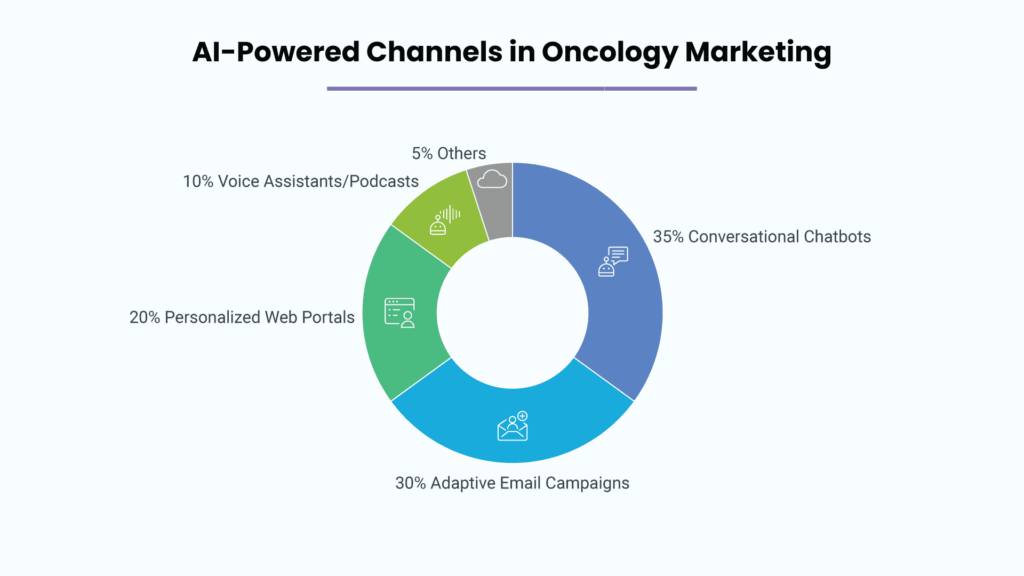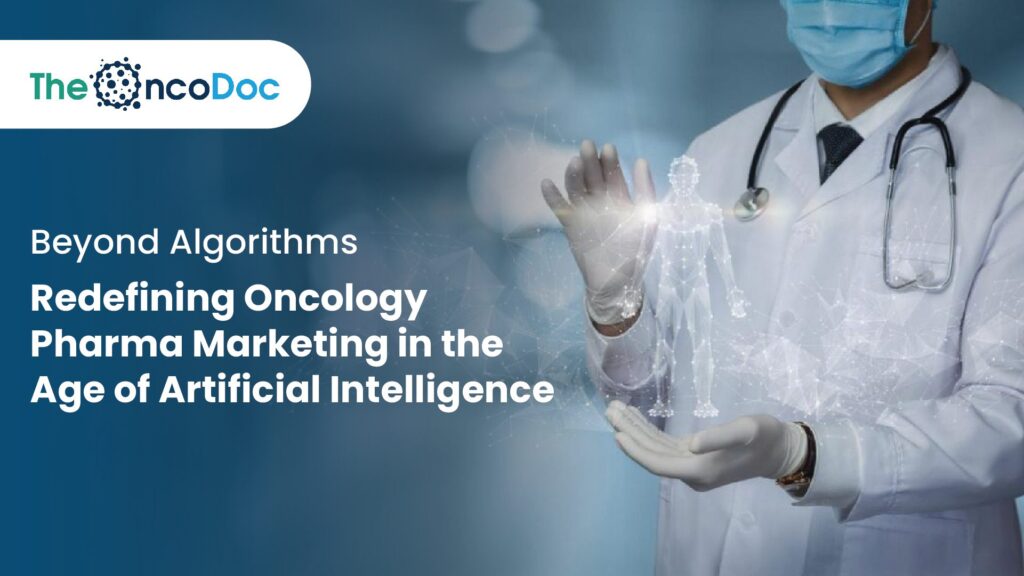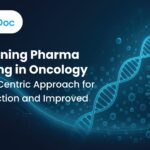Introduction: The Convergence of Oncology, AI, and Pharma Marketing
The oncology sector is witnessing a profound transformation, not only in how cancer is treated but in how critical information about treatment reaches physicians and patients. As medical AI accelerates discovery and diagnostics, pharmaceutical marketing, often seen as a laggard, must evolve from traditional, campaign-centric approaches into real-time, data-enriched, and hyper-personalized communication ecosystems. Artificial Intelligence (AI), when responsibly applied, enables this leap, making pharma marketers proactive participants in the cancer care journey, rather than peripheral voices.
This article explores the emergent role of AI in oncology-focused pharma marketing and how this fusion is redefining outreach, engagement, and trust across the healthcare continuum.
Section 1: Traditional Oncology Marketing: A Model Under Pressure
Historically, pharmaceutical marketing in oncology has relied heavily on in-person detailing, KOL (key opinion leader) advocacy, and medical conference presence. While these elements remain important, they are increasingly insufficient. Oncologists, faced with an ever-expanding array of new therapies and research, are seeking more meaningful engagement. Their expectations have shifted toward:
- Interactions grounded in clinical evidence rather than promotional messaging
- Customized insights tailored to their specialty and patient profiles, instead of one-size-fits-all presentations
Furthermore, the rise of precision medicine and targeted therapies has fragmented the market, making one-size-fits-all campaigns obsolete.
Enter AI.
AI offers pharma companies an opportunity to revamp their marketing strategy,by uncovering hidden patterns, predicting clinician preferences, and delivering relevant content at the right time and platform.
Section 2: AI Applications Reshaping Oncology Pharma Marketing
Artificial Intelligence is not a singular tool, it’s a set of capabilities that, when applied thoughtfully, can enhance every stage of pharma marketing.
1. Predictive HCP Targeting
Instead of static segmentation by specialty, AI allows for behavioral and needs-based targeting. By analyzing prescription trends, patient outcomes, EHR data, and digital interaction history, AI models can determine which oncologists are:
- Early adopters of novel therapies
- Skeptical but influential
- Likely to switch based on new efficacy data
Example in Practice: A pharma firm uses AI to predict that a cluster of hematologists in Tamil Nadu is underserved in educational content about CAR-T therapy. The company initiates a micro-campaign offering real-world evidence and case studies in regional languages.

2. AI-Driven Content Personalization
Generic newsletters and standard product brochures are rapidly being replaced by customized, data-driven content streams. AI analyzes a clinician’s browsing habits, past engagement, specialty, and patient demographics to serve content that is:
- Specialty-specific
- Timed with recent research developments
- Aligned with the oncologist’s case mix (e.g., early-stage breast cancer vs. metastatic lung cancer)
Implementation Tip: AI-powered recommendation engines can dynamically insert regionally relevant clinical trial updates into e-mailers for each recipient.
3. AI-powered Mapping of the Cancer Care Pathway
AI’s capability to analyze and anticipate each stage of a cancer patient’s journey enables marketers to design campaigns that are both compassionate and strategically timed to meet evolving needs.
Use Cases:
- Triggering awareness campaigns when a patient is likely to switch lines of therapy
- Identifying dropout patterns from oral chemo regimens and intervening via HCP education
- Aligning campaigns with diagnostic milestones (e.g., biomarker testing rates)
Section 3: Rethinking Engagement Channels: From Push to Predict
Traditional pharma engagement was ‘push’ based, physician outreach, detailing, and event sponsorships. AI enables a shift to predictive engagement, where companies anticipate when and how a healthcare professional (HCP) wants to engage.
Chatbots and Conversational AI for Oncologists
AI-powered chatbots, integrated into oncology platforms like OncoHub or institutional portals, can now:
- Answer clinical FAQs
- Provide drug interaction checks
- Deliver dosing calculators
- Fetch updated treatment guidelines
This ‘just-in-time’ information support significantly improves pharma’s value to HCPs.

Smart Event Planning
AI can suggest optimal times, geographies, and even topics for CME sessions or webinars by analyzing previous attendance, academic calendars, and search trends.
Case Example: A pan-India breast cancer educational series was dynamically scheduled using AI tools, leading to a 40% increase in oncologist turnout.
Real-Time Engagement Optimization and Omnichannel AI Strategy
Traditional engagement models treated every channel, email, mobile, in-person, webinars, as isolated efforts. Today, oncologists expect continuity across digital and physical touchpoints. AI can now unify these journeys, enabling marketers to switch from fragmented delivery to intelligent orchestration.
AI-Powered Omnichannel Journeys
An oncologist who opens a product summary via email might later search for related clinical trials on their EHR portal. With AI, that intent is captured and translated into follow-up actions, such as:
- Triggering a chatbot conversation with the latest efficacy data
- Auto-scheduling a rep visit tailored to the doctor’s research interest
- Offering a short podcast summary via mobile during commute hours
This predictive sequencing ensures a coherent and context-aware interaction, enhancing the HCP’s satisfaction and brand receptivity.
Real-Time Feedback Loops
Through Natural Language Processing (NLP) and sentiment analysis, AI can analyze HCP responses in emails, webinars, and even live discussions to detect emotional cues and comprehension gaps. These insights allow teams to:
- Adjust tone and complexity of follow-up messaging
- Prioritize urgent queries about adverse events or drug switches
- Detect if an oncologist is warming up to a new therapy
Impact Example: A multinational oncology brand integrated real-time sentiment analysis into its webinar Q&A sessions. It found that oncologists in tier-2 cities asked more safety-related questions, prompting regional managers to dispatch personalized safety data packs within 24 hours, doubling post-event engagement.
Section 4: Measuring What Matters: New KPIs in the AI Age
Marketing success in oncology isn’t measured by click-throughs alone. AI enables sophisticated measurement of:
- Clinical engagement depth (e.g., average time spent on clinical case simulations)
- Content relevancy score (measured by repeated HCP engagement)
- Knowledge retention, using adaptive assessments post-event
- Influence spread, by tracking downstream prescribing shifts among peer networks

This change highlights a larger movement toward prioritizing meaningful, value-driven engagement over high-volume marketing tactics.
Expanding AI Metrics to Capture Offline Influence and Peer Spillover
While AI excels at tracking digital metrics, oncology marketing still relies on human conversations, at tumor boards, hospital rounds, and medical societies. AI is now evolving to capture the impact of these offline, informal influence channels.
Using AI to Track Peer Spillover
Natural conversations among oncologists can result in therapy adoption. AI tools are beginning to:
- Map HCP referral networks using anonymized patient data
- Identify rising influencers through analysis of prescribing trends across clusters
- Detect the impact of regional KOLs on new drug uptake
By triangulating digital activity with offline prescribing trends, AI builds a 360° picture of engagement success.
Unified Attribution Models
Traditionally, it’s been hard to attribute whether an email, webinar, or a medical rep conversation led to a prescription switch. AI-based multi-touch attribution models now assign weight to each touchpoint using Bayesian inference, allowing marketers to understand:
- Which combinations drive conversion
- Where to reduce marketing spend without hurting performance
- When to switch HCPs from awareness to conversion journeys
Section 5: Ethical Imperatives and Guardrails in AI Marketing
AI brings power, and with power, ethical responsibility.
Key Ethical Considerations:
- Bias in Algorithms: Ensure that AI models are trained on diverse datasets to avoid marginalizing smaller or rural oncology segments.
- Data Privacy: Adhere strictly to data protection laws such as India’s Digital Personal Data Protection Act, HIPAA (US), and GDPR (Europe).
- Transparency: Inform HCPs when content is being tailored using AI, and offer opt-out options.
Using AI ethically goes beyond regulatory compliance—it’s essential for building and sustaining trust.
Ethical AI in Multilingual and Regional Outreach
India and many other emerging markets present a unique challenge: linguistic diversity. AI is a powerful enabler for multilingual marketing, but it must be done ethically and sensitively.
AI-Enabled Multilingual Content
With the help of Large Language Models (LLMs) and Neural Machine Translation, pharma marketers can now localize:
- Physician learning modules
- Drug safety information
- Patient FAQs
But mere translation isn’t enough. AI must preserve clinical accuracy and cultural nuance, especially when explaining side effects, dosage titrations, or risk-benefit profiles.
Best Practice: Collaborate with local medical experts to validate AI-translated material before deployment. Implement “human-in-the-loop” workflows to ensure contextual integrity.
Preventing Regional Bias
AI models trained mostly on data from metro cities may over-prioritize urban oncologists and under-represent rural HCPs. To combat this:
- Expand training datasets to include rural prescription data
- Balance campaign algorithms for underserved geographies
- Adjust tone and channel preferences based on tech literacy and access
Pharma brands that embrace this inclusive AI philosophy are not only more ethical but also more effective.
Section 6: The Future: From Marketers to AI-Enabled Clinical Partners
The line between pharmaceutical marketer and clinical partner is blurring. AI allows brand teams to co-create tools that aid in clinical decision-making.
AI Co-pilots for Oncologists
Imagine pharma-sponsored AI tools that:
- Help identify patient eligibility for newly approved therapies
- Visualize progression-free survival data against real-world cohorts
- Offer curated literature feeds tailored to a physician’s interests
These aren’t marketing tools in the traditional sense, they are decision-support systems that build brand credibility.
Generative AI Tools Empowering Clinical Decision-Making and Field Teams
The rise of Generative AI (GenAI) unlocks a new realm of creativity and productivity for both HCPs and pharma field teams. These tools are becoming co-pilots that synthesize vast oncology knowledge into usable insights.
For Oncologists
Imagine a GenAI-powered assistant that can:
- Summarize 10 latest studies on NSCLC (non-small cell lung cancer) into a 2-minute voice note
- Simulate patient outcomes based on biomarker profiles
- Draft insurance appeal letters for advanced therapies using real-world evidence
This isn’t theoretical, early pilots in North America and the EU are showing strong promise, with HCPs reporting over 30% reduction in cognitive load during treatment planning.
For Field Medical Reps
Generative AI tools can equip reps with:
- Custom-tailored product decks for each physician based on past interactions
- Automatic answer scripts for tough clinical queries
- AI-assisted meeting scheduling and route planning based on HCP availability and engagement probability
Case Insight: A leading oncology brand in India deployed a GenAI tool that created regional language versions of its KOL slide decks, resulting in a 3x increase in rural oncologist meeting conversions.
Section 7: Cross-Functional Collaboration: Breaking Down Silos
AI-powered marketing requires tight integration across departments:
- Medical Affairs: To validate AI recommendations and ensure scientific accuracy
- Regulatory Affairs: To navigate approval pathways for AI-assisted content
- IT & Data Science: To build and manage AI models
- Commercial Teams: To align insights with field strategies
Best Practice: Create “AI Pods” in your organization, agile, cross-functional units focused on rapid experimentation and iterative optimization.
Section 8: Patient-Centric AI Marketing: The Next Frontier
Although HCPs remain the primary audience, AI also enables ethical, compliant patient engagement.
Patient-Facing AI Use Cases:
- Symptom-checker bots that guide patients to oncologists
- Personalized educational journeys based on stage and type of cancer
- Voice assistants for chemotherapy adherence reminders
Pharma companies must ensure that these tools are inclusive, multilingual, and accessible, especially in low-resource settings.
AI for Equity in Access and Awareness
AI can also bridge gaps in cancer care accessibility, not just from a treatment perspective, but in awareness and education.
Geo-AI to Identify At-Risk Populations
By integrating cancer registry data, satellite demographics, and search behavior, AI can:
- Identify “oncology deserts” where late diagnoses are common
- Pinpoint districts with low screening rates
- Trigger localized awareness campaigns for oral cancer, cervical screening, etc.
Pharma firms can collaborate with public health agencies to deploy educational initiatives in these zones, creating a shared value ecosystem.
AI-Powered Virtual Tumor Boards
For hospitals lacking oncology specialists, AI can enable cloud-based tumor boards. These systems:
- Aggregate imaging, pathology, and genomics data
- Offer treatment path suggestions based on consensus guidelines
- Enable asynchronous discussion among regional experts
By sponsoring these AI platforms, pharma companies position themselves as healthcare enablers rather than just product providers.
Conclusion: AI as a Force Multiplier for Oncology Marketing Transformation
AI is not a silver bullet, but it is a force multiplier, one that allows oncology pharma marketers to deliver smarter, faster, and more empathetic engagement. By leveraging AI across targeting, personalization, channel selection, and impact measurement, pharma can move beyond transactions and into transformational partnerships with the oncology community.
Those who succeed will not be those who market the most, but those who matter the most in the oncologist’s clinical ecosystem.
Let AI augment your message. Let empathy guide your strategy. Let trust define your impact
The Oncodoc team is a group of passionate healthcare and marketing professionals dedicated to delivering accurate, engaging, and impactful content. With expertise across medical research, digital strategy, and clinical communication, the team focuses on empowering healthcare professionals and patients alike. Through evidence-based insights and innovative storytelling, Hidoc aims to bridge the gap between medicine and digital engagement, promoting wellness and informed decision-making.



